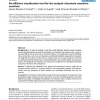Free Online Productivity Tools
i2Speak
i2Symbol
i2OCR
iTex2Img
iWeb2Print
iWeb2Shot
i2Type
iPdf2Split
iPdf2Merge
i2Bopomofo
i2Arabic
i2Style
i2Image
i2PDF
iLatex2Rtf
Sci2ools
BMCBI
2008
2008
An efficient visualization tool for the analysis of protein mutation matrices
Background: It is useful to develop a tool that would effectively describe protein mutation matrices specifically geared towards the identification of mutations that produce either wanted or unwanted effects, such as an increase or decrease in affinity, or a predisposition towards misfolding. Here, we describe a tool where such mutations are efficiently identified, categorized and visualized. To categorize the mutations, amino acids in a mutation matrix are arrang according to one of three sets of physicochemical characteristics, namely hydrophilicity, size and polarizability, and charge and polarity. The magnitude and frequences of mutations for an alignment are subsequently described using color information and scaling factors. Results: To illustrate the capabilities of our approach, the technique is used to visualize and to compare mutation patterns in evolving sequences with diametrically opposite characteristics. Results show the emergence of distinct patterns not immediately dis...
Amino Acid | BMCBI 2008 | Mutation Matrix | Mutations |
| Added | 09 Dec 2010 |
| Updated | 09 Dec 2010 |
| Type | Journal |
| Year | 2008 |
| Where | BMCBI |
| Authors | Maria Pamela C. David, Carlo M. Lapid, Vincent Ricardo M. Daria |
Comments (0)

